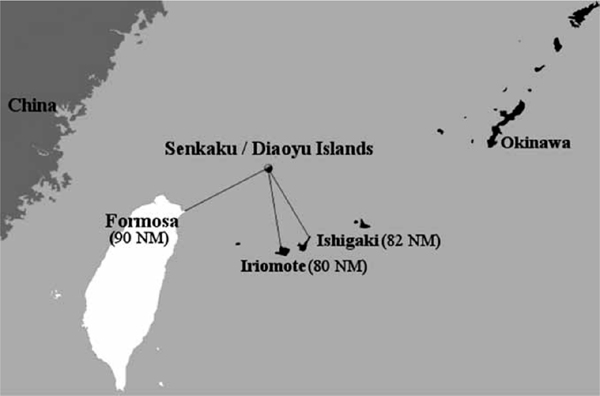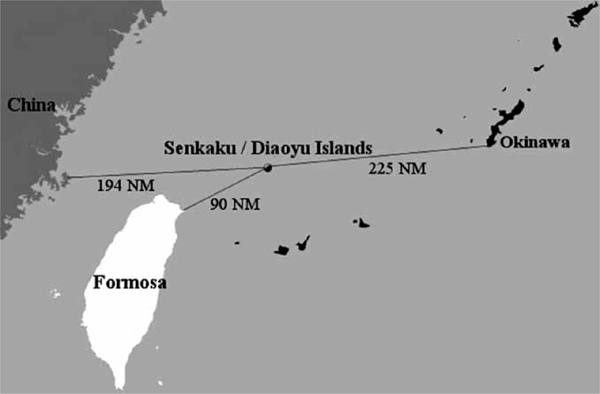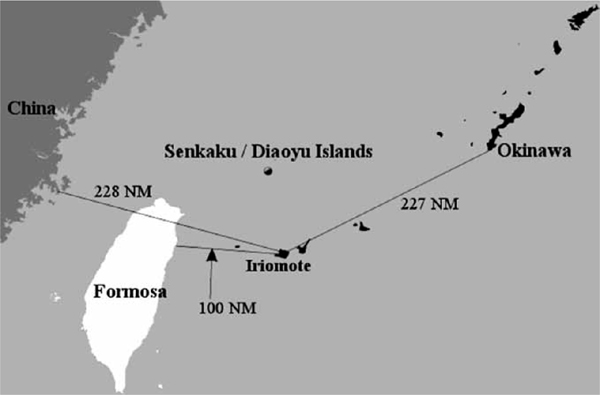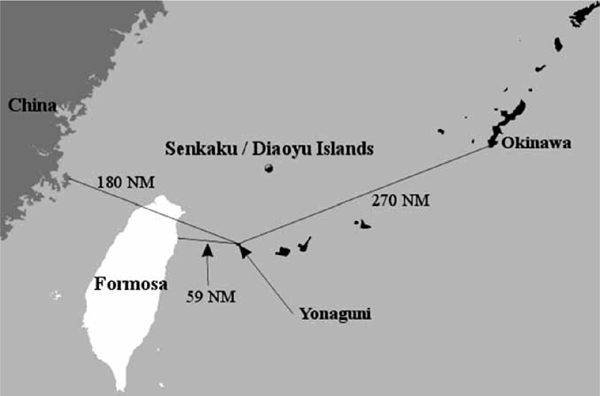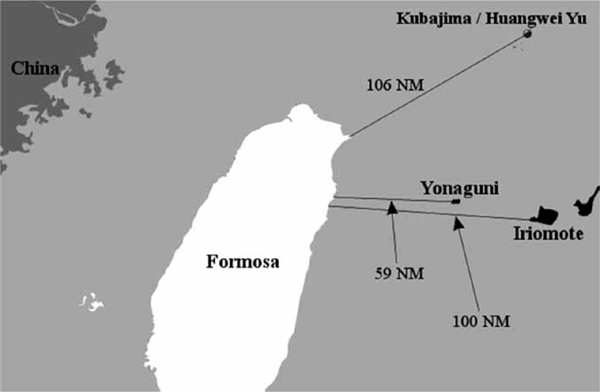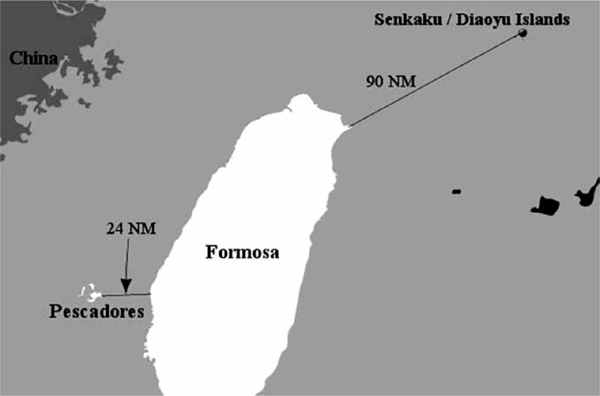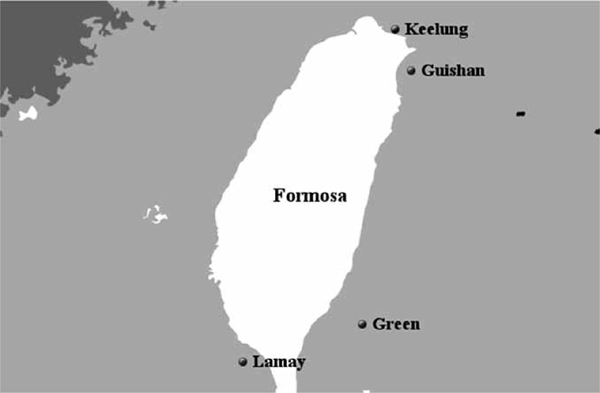Sovereignty over the Senkaku/Diaoyu Islands: A Guide to the Legal Debate
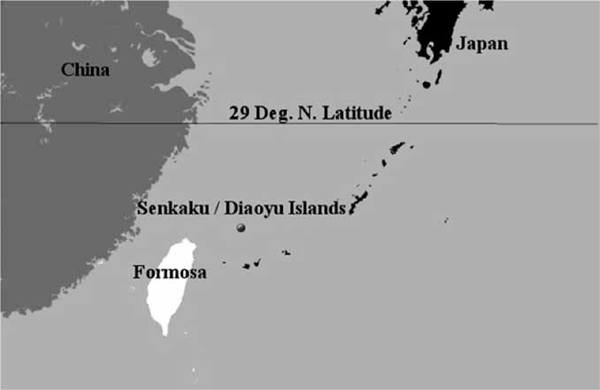
Chapter 4
Sovereignty over the Senkaku/Diaoyu Islands: A Guide to the Legal Debate
Debates about sovereignty over the Senkaku/Diaoyu Islands pay insufficient attention to international law. Commentators and media outlets often depict the dispute in primarily historical terms by focusing on the chronology of each state’s effective control (Shaw 2012). In these analyses, there is little attempt to connect history to legal doctrine, as if ancient events somehow possess their own dispositive force. To make matters worse, the few extant legal analyses are generally unsatisfying. Most of them fail to scrutinize important treaty texts, overlook key legal doctrines, emphasize historical facts that are irrelevant, suffer from heavy doses of nationalistic partisanship, and make no attempt to explain how the array of subsidiary legal questions interrelate (Chiu 1996; Heflin 2000; Shaw 2008; Manjiao 2011). The result is a certain level of analytical chaos, and a general sense that the issue is too knotty for principled resolution. But it does not have to be this way. This chapter attempts to bring clarity and order to the sovereignty debate through a close analysis of key texts and legal principles. First, I simplify the debate by identifying a number of commonly raised issues that are immaterial as a matter of law. Next, I organize the debate by identifying and evaluating the legal questions that matter: 1) whether the islands were unoccupied territory when Japan annexed them in 1895, 2) whether Japan ever acquired title under the doctrine of acquisitive prescription, and 3) whether the Allies made a lawful determination in favor of Japanese title after the Second World War in accordance with the Potsdam Declaration and Instrument of Surrender. Finally, I suggest that Japan likely has sovereignty due to the doctrine of acquisitive prescription, which is no more indeterminate than the doctrine of occupation on which China relies, and which trumps China’s possible original occupation as a later-in-time source of title. Prewar acquisitive prescription from 1895 to 1937 confirms that the Cairo and Potsdam Declarations did not transfer sovereignty to China and establishes that the 1951 San Francisco Peace Treaty’s allocation of sovereignty to Japan was lawful. Post-war acquisitive prescription from 1951 to 1970 forms a second, freestanding basis for the Japanese claim. In justifying these conclusions, this chapter offers an answer to the question of who can rightly claim sovereignty.
Red Herring in the East China Sea
At the center of the dispute over the Senkaku/Diaoyu Islands is the question of sovereignty: to which state do the islands belong? Because the parties have collected a range of historical evidence, relied upon a variety of treaties and official declarations, and asserted multiple alternative theories of title, the question has an air of complexity. Upon close inspection, however, many of the common arguments are legally irrelevant. This section simplifies the dispute by identifying and clearing away the clutter of issues that cannot affect title to the islands.
The Treaty of Shimonoseki
Signed at the conclusion of the First Sino-Japanese War in April 1895, the Treaty of Shimonoseki provided in part that China “cedes to Japan in perpetuity and full sovereignty … [t]he island of Formosa, together with all islands appertaining or belonging to the said island of Formosa” (art. 2(b)). The parties disagree on whether this language encompassed the Senkaku/Diaoyu. Under the Japanese view, the language did not, the Treaty is inapplicable, and sovereignty hinges on other issues (MOFA 2013). Under the Chinese view, the Treaty transferred sovereignty over the islands to Japan, and China reacquired sovereignty through the Treaty’s subsequent invalidation (Chinese State Council Information Office 2012). To support the latter part of this argument, the Republic of China (ROC) relies upon the ROC–Japan Peace Treaty of 1952 (Treaty of Taipei), in which the parties “recognize[d] that all treaties, conventions, and agreements concluded before December 9, 1941, between China and Japan have become null and void as a consequence of [World War II]” (art. 4). According to Taiwan, this language invalidated the Treaty of Shimonoseki and in doing so reversed the original cession to Japan (Ministry of the Interior 2012). The People’s Republic of China (PRC) makes a similar argument based on China’s 1941 declaration of war, which stated, “all treaties, conventions, agreements, and contracts regarding relations between China and Japan are and remain null and void” (reprinted in Chiu 1973). The PRC further asserts that the Treaty of Shimonoseki was of no effect because Japan achieved its terms through military conquest (Chinese State Council Information Office 2012). In short, the Chinese contention is that China gave sovereignty to Japan in the Treaty of Shimonoseki, and either Japan gave it back in the Treaty of Taipei, Shimonoseki was invalid to begin with, or China unilaterally nullified the original transfer in 1941. Ultimately, this position is unpersuasive because it does not comport with Shimonoseki’s text, context, or drafting history. Thus, neither that treaty, nor the 1941 declaration, nor the Treaty of Taipei matters.
The analysis begins with several background points. First, “appertain” does not appear to carry a meaning materially different from “belong.” Common usage suggests that they are functionally identical (OED Online n.d.), and the Treaty of Shimonoseki lacks any definitional provisions to suggest non-ordinary meaning. Second, to “appertain[] or belong[]” holds a natural geographic, rather than a political, orientation. The text supports this view by including within the cession of territory all islands that appertain or belong to the “Island of Formosa” (art. 2(b)), rather than, for example, the “Province of Taiwan.” If the Treaty had used the latter phrasing, one might reasonably determine the amount of territory ceded by looking simply to the boundaries of the province in 1895 and concluding that the Treaty transferred to Japan only those islands belonging to the same political unit. By focusing instead on natural geography, the text suggests a different analysis that hinges on the physical relationship between Formosa and any surrounding islands. A separate provision in the Treaty confirms this reading by requiring China to cede “all islands appertaining or belonging to the Province of Fengtien” (art. 2(a)). If the Treaty is to mean what it says, one must assume that the use of natural geographic terminology with respect to Formosa, together with political terminology elsewhere, was purposeful. Finally, the only plausible natural geographic criteria for determining the relationship between islands are distance and seabed topography. Of these, the first seems more likely, given the extremely limited state of knowledge about seabed topography in the late nineteenth century (Kunzig 2000, pp. 32–9).1
There are several conceivable ways of applying the distance and topography criteria. For distance, one method would hold that an island or island group appertains or belongs to Formosa only if it is closer to Formosa than to any other land features, however minor in size. Another would hold that an island or island group appertains or belongs to Formosa as long as it is closer to Formosa than to either of the other major land features in the region: the island of Okinawa and the Chinese mainland. Yet another would hold that islands appertain or belong to Formosa only if they are within a fixed distance of its shoreline—100 nautical miles, for example. I will call these the all features, major features, and absolute distance tests, respectively. As for seabed topography, one possibility would maintain that islands appertain or belong to Formosa if they share the same continental shelf. Another would maintain that islands must instead come from the same rise out of the continental shelf as Formosa to fall within the scope of the Treaty. These are the continental shelf and seafloor rise tests.
Given these options, Japan has the stronger position in arguing that the Treaty of Shimonoseki did not transfer sovereignty over the Senkaku/Diaoyu. First, the islands do not even arguably appertain or belong to Formosa under two of the possible approaches. Under the all-features test, the islands would fall outside the scope of the Treaty because they are approximately ten nautical miles closer to the Japanese islands of Ishigaki and Iriomote than to Formosa (Distance Measurement Tool n.d.) (see Figure 4.1). Likewise, under the seafloor-rise test, the islands are beyond the scope of the Treaty because their only topographical commonality with Formosa is their location on China’s continental shelf (GEBCO World Map 2013).
Figure 4.1 All features test
Second, all of the metrics under which the islands would appertain or belong to Formosa are over-inclusive. Under the major features test, the Treaty would have transferred sovereignty over the Senkaku/Diaoyu because they are substantially closer to Formosa than to the other major land features in the area (see Figure 4.2).2 Yet parts of the Yaeyama Islands, such as Iriomote and Yonaguni, are also closer to Formosa than to the other major alternatives and were undisputedly Japanese territory well before Shimonoseki (Distance Measurement Tool n.d.; McCormack 2012) (see Figures 4.3 and 4.4). Thus, relative proximity to Formosa cannot be determinative. Similarly, under the absolute distance test, the Treaty would have transferred sovereignty over the Senkaku/Diaoyu if the text encompassed all islands at least as far from Formosa as Kubajima/Huangwei Yu, which is the northernmost part of the Senkaku/Diaoyu group and about 106 nautical miles away (Distance Measurement Tool n.d.). But that approach would also encompass parts of the Yaeyama Islands (ibid.). Yonaguni, for instance, is only 59 nautical miles from Formosa (ibid.) (see Figure 5). Thus, for one of these approaches to reflect the meaning of the Treaty, the Qing dynasty must have either purported to cede a number of islands over which it clearly had no sovereignty to begin with, or agreed upon an exception for Japanese islands that “appertained” or “belonged” to Formosa under the intended meaning of those terms. The former scenario is implausible, and there is no textual evidence of the latter. If distance is the criterion, the only way to avoid the problem of over-inclusiveness is to adopt an interpretation under which no part of the Yaeyama Islands appertain or belong to Formosa. Such an interpretation will necessarily exclude the Senkaku/Diaoyu Islands.
Figure 4.2 Major features test—Senkaku/Diaoyu
The continental-shelf test also would be over-inclusive, but in a different way. Taken to its logical conclusion, that approach would mean that the Treaty accomplished, with modest language, the transfer of sovereignty over not just the Senkaku/Diaoyu, but all other small islands on the entire continental shelf, including numerous islands immediately off the coast of mainland China, regardless of distance from Formosa. This territory would include everything from the island of Beishi, near Hainan; to the Pratas Islands; a swath of islands in Fujian Province; and a series of islands near Shanghai, among numerous others (GEBCO World Map 2013). Yet no one acted as if such transfers occurred (Berger 1982, pp. 164–202). That they did not suggests that this test fails to reflect the intended meaning of the text.
Also problematic is that the Chinese position renders redundant a separate Treaty provision that transferred sovereignty over the Pescadores Islands. At 24 nautical miles west of Formosa, the Pescadores are substantially closer to Formosa than the Senkaku/Diaoyu, much closer to Formosa than either the island of Okinawa or the Chinese mainland, and on the same continental shelf as Formosa (Distance Measurement Tool n.d.; GEBCO World Map 2013) (see Figure 4.6). Given this geography, the Pescadores appertain or belong to Formosa under all of the tests that would include the Senkaku/Diaoyu in the ceded territory. And yet the drafters found it necessary to transfer the Pescadores explicitly and in an entirely separate provision (art. 2(c)). This might suggest that the parties did not envision any of the relatively expansive tests. Put differently, the only way to avoid rendering the language on the Pescadores redundant is to interpret “islands appertaining or belonging to the … Island of Formosa” as referring exclusively to islands that are closer to Formosa than the Pescadores, or that share a topographical relationship greater than location on the same continental shelf. Once again, those interpretations necessarily exclude the Senkaku/Diaoyu.
Figure 4.3 Major features test—Iriomote
Figure 4.4 Major features test—Yonaguni
Figure 4.5 Absolute distance test
Figure 4.6 The Pescadores
Finally, the Chinese position is less persuasive because of chronology: Japan unilaterally annexed the islands in January 1895, over three months before the parties signed the Treaty of Shimonoseki (Taira 2004). Given that act, it is questionable that Japan understood the Treaty as the source of its sovereignty. To negotiate for the transfer of the islands only months after annexing them would have been bizarre; the Japanese government would have had to believe that its own action was an insufficient basis for title or otherwise problematic. I am not aware of any evidence that it did.3
I do not mean to suggest that these arguments are entirely conclusive. China might challenge them in two ways. First, while the Chinese position renders the provision on the Pescadores redundant, it does not necessarily render it superfluous. Because of their strategic location and harbor, regional powers historically viewed the Pescadores as key to the capture of Formosa, and the Pescadores played an important role in the First Sino-Japanese War (Davidson 1903, pp. 266). It is possible, therefore, that Japan demanded a separate provision on those islands simply out of an abundance of caution. The negotiating parties may have understood, in other words, that the language regarding Formosa was broad enough to encompass the Pescadores, but added the separate provision to make the transfer of sovereignty over them indisputably clear.
Second, the chronology argument presupposes that it is permissible to consider context in ascertaining the meaning of the text. There is no authority, however, on how to interpret the Treaty. While modern international law supplies codified rules of interpretation (Vienna Convention on the Law of Treaties 1969, art. 31–33), that law entered into force in 1980 and is non-retroactive (ibid., art. 4), and the customary practices that the modern rules codified had not yet developed in the late nineteenth century (Oppenheim 1912, p. 582). The result is that there is no clear legal basis for considering context as an indicator of meaning, or for following any other rule of interpretation, and meaning necessarily remains somewhat unsettled.
Neither of these challenges, however, seems to do more than keep the Chinese position on life support. While an expansive interpretation of the Formosa provision might not make the provision on the Pescadores superfluous, China’s position does not enjoy any affirmative textual support. The Treaty, after all, never says a word about the Senkaku/Diaoyu, and there is no evidence that the parties discussed the islands during negotiations (Berger 1982, pp. 164–202). Moreover, just as there is no applicable rule of treaty interpretation that permits reliance upon context, neither is there a rule against it. All of this is important because international tribunals have declined in several cases to rule on the basis of a treaty that did not clearly apply to a disputed territory. Examples of this practice occurred in the Minquiers and Ecrehos Case (France v. United Kingdom) (International Court of Justice (ICJ) 1953, p. 54) and Territorial and Maritime Dispute (Nicaragua v. Colombia) (ICJ 2012, pp. 40–56). The foregoing analysis suggests that an international court would do the same with the Treaty of Shimonoseki.
In summary, only relatively restrictive interpretations of the Treaty of Shimonoseki can avoid the problems of over-inclusiveness, redundancy, and chronology. One such interpretation is a limited version of the absolute distance test, which would hold that islands appertain or belong to Formosa only if they are closer to Formosa than the Pescadores are. Islands that satisfy this requirement include Keelung, Green, Guishan, and Lamay, all of which are within approximately twenty nautical miles of Formosa’s shoreline (Distance Measurement Tool n.d.) (see Figure 4.7). The other remaining interpretation is that islands appertain or belong to Formosa only if they rise together with Formosa out of the continental shelf. Because both of these easily exclude the Senkaku/Diaoyu, the Treaty is irrelevant to the sovereignty debate. This in turn means that the 1941 declaration of war and the 1952 Treaty of Taipei are also irrelevant; if the Treaty of Shimonoseki did not transfer sovereignty to Japan, neither of the other documents could have transferred sovereignty back to China by invalidating Shimonoseki.
Figure 4.7 Minor islands
Geography
Some assert that the location of the Senkaku/Diaoyu Islands favors Chinese sovereignty. The Taiwanese Ministry of the Interior, for example, cites as supporting evidence the islands’ location on China’s continental shelf, where they are easy to reach from Taiwan because of favorable air and water currents (2012). International law is clear, however, that location per se is inconsequential (Chemillier-Gendreau 2000, pp. 27–9). In the Island of Palmas Case, the Permanent Court of Arbitration explained: “It is impossible to show the existence of a rule of positive international law to the effect that islands situated outside territorial waters should belong to a State from the mere fact that its territory forms the terra firma (nearest continent or island of considerable size)” (Permanent Court of International Arbitration 1928, p. 854). Not only would such a rule be “wholly lacking in precision,” its application would “lead to arbitrary results” and contradict well-established doctrines that emphasize effective control as a critical determinant of title (ibid., p. 854–5). The result is that the location of the islands on China’s continental shelf, in comparative proximity to the Chinese mainland, is in itself insignificant.
Acts of Private Individuals
Commentators and official state publications also have pointed to the conduct of private individuals as evidence of sovereignty. The Taiwanese Ministry of the Interior emphasizes that the Senkaku/Diaoyu were “popular among [Chinese] fishermen who sought shelter on the[] islands during storms and repaired boats and equipment on their shores,” and that the Chinese also used the islands as a place to gather medicinal herbs and dismantle salvaged boats (2012). Other publications discuss how Japanese citizens built a lighthouse on the islands in the 1980s (Hajime 2013). Yet such acts are generally irrelevant. In the Case Concerning Sovereignty Over Pulau Ligitan and Pulau Sipadan (Indonesia v. Malaysia), for example, Indonesia argued that the traditional use of waters surrounding certain disputed islands by Indonesian fishermen supported its claim to sovereignty, but the ICJ rejected that argument and explained that the “activities by private persons cannot be seen as [evidence of sovereignty] if they do not take place on the basis of official regulations or under governmental authority” (2002, p. 683).4 The basic contours of this rule have been in place since at least the nineteenth century (Phillimore 1854, p. 198).
Most Official Acts After 1970
Most of the official conduct by the Japanese and Chinese governments over the last 45 years is also immaterial to the analysis. Once a sovereignty dispute crystallizes, a development marked by the so-called “critical date,” the law discounts the relevance of all subsequent acts that either party undertakes to improve its legal position (Jennings 1963l, pp. 20–23). The goal of this doctrine is twofold. First, it aims to reduce the risk of military or other conflicts that might arise from simultaneous acts of sovereignty by the competing parties (Goldie 1968, p. 1,253). By deeming most subsequent acts irrelevant, the law reduces the incentive for a party to disturb the status quo. Second, the doctrine aims to protect the quality of the evidence on which sovereignty may depend by eliminating the incentive for parties to create new facts in support of their claims once a dispute has arisen (Reisman 1999, p. 678). Underlying this particular goal is the assumption that official acts that occur prior to the crystallization of a dispute are more genuine indicia of sovereignty or its absence because parties undertake such acts without an eye toward the response of other parties or international tribunals.
For the dispute over the Senkaku/Diaoyu, the most likely critical date is approximately 1970, shortly after the UN Economic Commission for Asia and the Far East reported a high probability of massive deposits of oil and natural gas underneath the waters surrounding the islands (Austin 1998, p. 163). This is the point at which the parties understood the economic stakes of sovereignty and began to assert competing claims. In July 1970, the Japanese ambassador to Taiwan communicated Japan’s claim to the PRC (Shaw 1999, p. 11), and in December 1970, Taiwan declared the islands to be Chinese territory (Hagstrom 2005, p. 120; Lee 2002, p. 6). As a result, the overwhelming majority of official acts that have occurred in the decades since are inconsequential. It is generally of no moment, for example, that the Japanese government purchased some of the islands in 2012 (The Daily Telegraph 2012), that Chinese vessels have visited the surrounding waters with frequency in recent years (Japan Times 2013), or even that the United States supported Japanese sovereignty in 1971 by signing the Okinawa Reversion Agreement (art. I.1). At most, such acts demonstrate only that neither party has acquiesced in the sovereignty claim of the other; they cannot support title as evidence of effective control.
Some have suggested instead that the critical date is 1895, when Japan both annexed the islands and allegedly acquired them from China through the Treaty of Shimonoseki (Shaw 2008, p. 156). This view rests on the assumption that the critical date is the point at which one state begins to act in any way inconsistent with the title of another. The law, however, does not support that assumption (Goldie 1968, p. 1,255). International tribunals have explained that the critical date is the point at which the parties contest title (Case Concerning Sovereignty Over Pulau Ligitan and Pulau Sipadan 2002, p. 682; Minquiers and Ecrehos Case 1953). Under this precedent, 1895 cannot be the critical year because no contest occurred if China ceded the islands to Japan, and I am aware of no evidence of a Chinese objection to Japanese annexation and control in the late nineteenth or early twentieth century. Finally, a critical date of 1895 would operate in tension with the doctrine of acquisitive prescription, which holds that one state can obtain title over part of the territory of another by asserting effective control in a peaceful and public manner, without interruption, for a sufficient period (Jennings 1963, pp. 20–23; Johnson 1950, pp. 344–7). If the first attempt to exercise control over another state’s territory marked the critical date, acquisitive prescription would become virtually impossible because the law would bar consideration of nearly all evidence of the acquiring state’s effective control (Fitzmaurice 1955, 32–4). That international law generally recognizes such evidence demonstrates that an attempt to establish effective control does not itself set the critical date.
Three Key Questions
The first section identified commonly discussed topics that do not matter. This section argues that there are only three issues on which sovereignty depends: 1) whether the islands were unoccupied terra nullius when Japan annexed them in 1895; 2) whether Japan ever acquired title under the doctrine of acquisitive prescription; and 3) whether the Allies made a lawful determination in favor of Japanese title after the Second World War in accordance with the Potsdam Declaration and Instrument of Surrender.
Whether the Islands were Terra Nullius in 1895
The first critical part of the sovereignty debate concerns the status of the islands at the time of Japanese annexation in 1895. Relying upon a variety of historical evidence, China contends that the islands were Chinese territory in 1895 and had been for centuries (Chinese State Council Information Office 2012). Japan responds that the islands were unoccupied territory, or “terra nullius,” as revealed by official surveys prior to annexation (MOFA 2013). For China, title in 1895 is a prerequisite to a valid claim today; if the islands were terra nullius, there is no plausible theory under which the islands can now belong to China. If the islands were Chinese, however, Japan might still have valid title today if China subsequently acquiesced to Japan’s effective control in accordance with the doctrine of acquisitive prescription, as discussed below.
Whether the islands were terra nullius depends upon the doctrines of occupation and intertemporality. The former holds that a state can appropriate unclaimed territory by occupying and possessing it (Jennings 1963, p. 20). The latter holds that one must judge the legality of events in light of the law contemporaneous with their occurrence, rather than with the law in force at the time the dispute is ultimately resolved (Island of Palmas Case 1928). In other words, lawful annexation by Japan requires that China had not already engaged in acts sufficient to appropriate the islands under the law of occupation that existed up to 1895.
Given these rules, China likely possessed original sovereignty over the islands from the fourteenth to at least the eighteenth century. Early international law held that discovery could form the basis for occupation (Oppenheim 1912, p. 294; Island of Palmas Case
